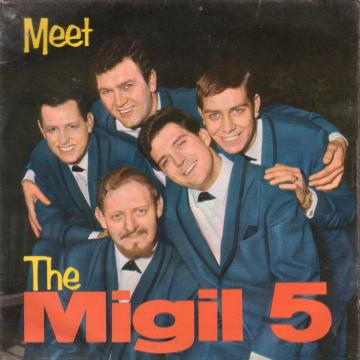|
Mike Felix, Gilbert Lucas and Lenny Blanche
had originally started out as a three piece jazz combo before
adding Red Lambert to the line-up. At this point they became
the Migil 4, making the unusual name up for the group from the
first two letters of founders Felix and Lucas christian names.
It was in this new guise that their style took a turn towards
rhythm and blues. However, it was the addition of saxophonist
Alan Watson- thus becoming the Migil 5- that allowed them to
create a fuller sound. It was this line-up that produced their
only UK top ten hit, "Mockin' Bird Hill". It is notable
because, although the group came out of the North London area,
it adopted a strong 'ska' beat which was then still unusual outside
of the West Indies. |
Pictured on the right is the Migil Five's sole release on the
EP format (Pye NEP24191); now extraordinarily difficult to find
in nice condition. The cover has a great picture of the group
as they were in 1964 and the disc contains songs that are very
difficult to obtain in any format. These include their interpretation
of the Johnnie Ray classic, 'Cry'.
|

|
|
Apart from one further minor hit in a similar
lilting style to Mockin' Bird Hill, the group were unable to
find much more success on record. They continued to prove popular
live performers, but the original quintet began to fall apart
beginning with the defection of drummer/ lead vocalist Mike Felix
who wanted to try his hand on his own (he cut two unsuccessful
solo singles- see obscure artists-m). The Migil 5 went on playing until 1971 with
Norman Langford replacing Alan 'Earl' Watson- who left in 1969
to run a Canvey Island pub. In fact the group seems to have generally
drifted towards Essex- Lenny Blanche started a successful restaurant
(The Boatyard) at Leigh On Sea and Gil Lucas moved into the business
of pub and entertainment management, but didn't give up his music.
Up until the time of Gil's untimely death he was still playing
in a trio in the Palm Tree, Mile End. So sadly we are not going
to see the original Migil 5 on the nostalgia circuit. |

